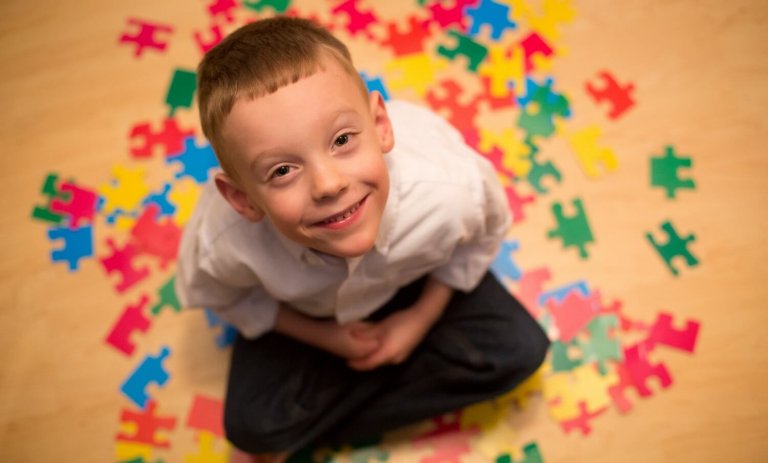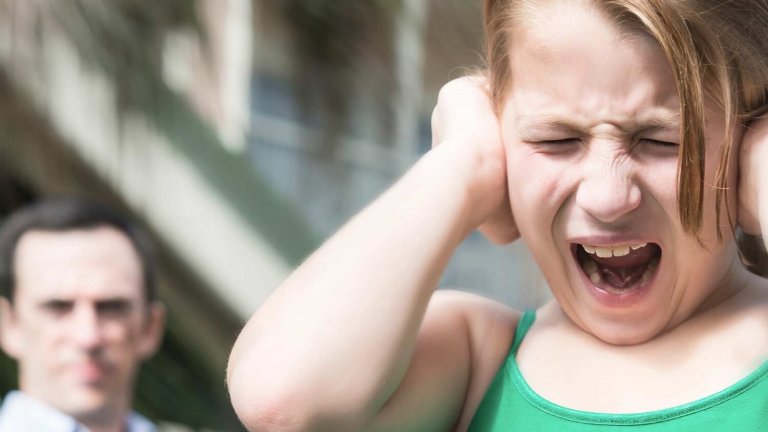Discover How a Child with Autism Sees the World

It’s never easy to imagine how others see or experience the world. Even more difficult is to put ourselves in the place of a child with autism and understand how they perceive their surroundings, how they feel and what they think.
Walking a mile in somebody else’s shoes is far from simple, but it’s worth the effort. By finding out how a child with autism sees the world, you’ll understand them a little better.
Stimuli and autism
Children with autism face many obstacles on a daily basis, not just in terms of their own life but also how society sees them. Often, others have no idea how to understand how they feel or how they see the world around them.
A situation that is completely normal for you, such as going to a busy shopping mall, may be stressful and threatening to a child with autism.
People who have autism are very sensitive to the stimuli they receive from their environment. When they’re bombarded with sensory stimuli, they may feel disoriented, overwhelmed and distressed.
It’s important to understand that, when a child with autism has a tantrum, there is always a reason. The child isn’t doing it for attention: something has happened that has pushed them to the limit of their tolerance.
An insight into how a child with autism sees the world
A campaign by the National Autistic Society sums up this situation with its campaign: “Too Much Information.”
This British organization aims to educate the public to understand and empathize by showing how a child with autism sees the world.
When a child with autism receives too many stimuli, he or she may reach the point of meltdown.
With this in mind, the National Autistic Society wants to raise awareness of how children and adults with autism see the world to avoid situations where, for example, a person with autism is asked to leave a public space due to their behavior.
Many people with autism and their families feel that society doesn’t understand them, and isolates them.

The brain of a child with autism is “wired” differently. This can make everyday situations feel chaotic. Every sense fires at the same time to understand all the information coming in, causing significant distress.
It’s time for society to wise up to how children with autism see the world. This awareness will help put an end to the isolation that many people with autism feel.
For children with autism, going to a place full of people, noise, lights, smells and colors means being bombarded with stimuli. The short video below will help you understand how it feels.

How to react
It’s also useful for members of the public to know how to react when a child with autism displays “inappropriate” behavior due to overstimulation.
Children with autism are a part of our communities, and it’s all of our job to help them feel more at ease. Some strategies to do this include:
- Giving the child time to process information.
- Not crowding around during a tantrum or judging the child or their family.
- Allow the family to create a space of silence and protection for the child to calm down.
- Ask the family if they need help of any kind.
- Think: how would I like to be treated when I’m on the edge of a meltdown?
- Empathize, don’t criticize.
As the end of the video says: “I’m not naughty, I’m autistic, and I just get too much information.”
Don’t miss this video, and when you’ve seen it, reflect on how it makes you feel. Discover how a child with autism feels in this kind of situation.
https://youtu.be/Lr4_dOorquQ
It’s never easy to imagine how others see or experience the world. Even more difficult is to put ourselves in the place of a child with autism and understand how they perceive their surroundings, how they feel and what they think.
Walking a mile in somebody else’s shoes is far from simple, but it’s worth the effort. By finding out how a child with autism sees the world, you’ll understand them a little better.
Stimuli and autism
Children with autism face many obstacles on a daily basis, not just in terms of their own life but also how society sees them. Often, others have no idea how to understand how they feel or how they see the world around them.
A situation that is completely normal for you, such as going to a busy shopping mall, may be stressful and threatening to a child with autism.
People who have autism are very sensitive to the stimuli they receive from their environment. When they’re bombarded with sensory stimuli, they may feel disoriented, overwhelmed and distressed.
It’s important to understand that, when a child with autism has a tantrum, there is always a reason. The child isn’t doing it for attention: something has happened that has pushed them to the limit of their tolerance.
An insight into how a child with autism sees the world
A campaign by the National Autistic Society sums up this situation with its campaign: “Too Much Information.”
This British organization aims to educate the public to understand and empathize by showing how a child with autism sees the world.
When a child with autism receives too many stimuli, he or she may reach the point of meltdown.
With this in mind, the National Autistic Society wants to raise awareness of how children and adults with autism see the world to avoid situations where, for example, a person with autism is asked to leave a public space due to their behavior.
Many people with autism and their families feel that society doesn’t understand them, and isolates them.

The brain of a child with autism is “wired” differently. This can make everyday situations feel chaotic. Every sense fires at the same time to understand all the information coming in, causing significant distress.
It’s time for society to wise up to how children with autism see the world. This awareness will help put an end to the isolation that many people with autism feel.
For children with autism, going to a place full of people, noise, lights, smells and colors means being bombarded with stimuli. The short video below will help you understand how it feels.

How to react
It’s also useful for members of the public to know how to react when a child with autism displays “inappropriate” behavior due to overstimulation.
Children with autism are a part of our communities, and it’s all of our job to help them feel more at ease. Some strategies to do this include:
- Giving the child time to process information.
- Not crowding around during a tantrum or judging the child or their family.
- Allow the family to create a space of silence and protection for the child to calm down.
- Ask the family if they need help of any kind.
- Think: how would I like to be treated when I’m on the edge of a meltdown?
- Empathize, don’t criticize.
As the end of the video says: “I’m not naughty, I’m autistic, and I just get too much information.”
Don’t miss this video, and when you’ve seen it, reflect on how it makes you feel. Discover how a child with autism feels in this kind of situation.
https://youtu.be/Lr4_dOorquQ
All cited sources were thoroughly reviewed by our team to ensure their quality, reliability, currency, and validity. The bibliography of this article was considered reliable and of academic or scientific accuracy.
- Álvarez, I., & Arroyo Ignacio, C. (2016). Bases genéticas del autismo. Acta Pediátrica de México. https://doi.org/10.18233/apm31no1pp22-28
- Assumpção Jr, F. B., & Pimentel, A. C. M. (2000). Autismo infantil. Brazilian Journal of Psychiatry, 22, 37-39. http://www.scielo.br/scielo.php?pid=S1516-44462000000600010&script=sci_arttext&tlng=pt
- Cuxart i Fina, F. (2000). El Autismo : aspectos descriptivos y terapéuticos. Aljibe.
- Ritvo ER, Ornitz EM. (1976). Autism: diagnosis, current research and management. New York: Spectrum.
- Rivière, A. (2001). Autismo. Orientaciones para la intervención educativa. Madrid: Trotta. SA Cómo potenciar la comunicación en el alumnado con trastorno del espectro autista.
This text is provided for informational purposes only and does not replace consultation with a professional. If in doubt, consult your specialist.








